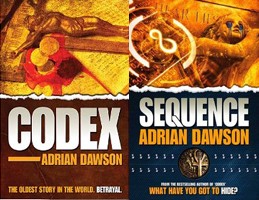 Adrian Dawson’s first book Codex found considerable success. It opens with what appears to be a terrorist bombing and becomes a puzzling thriller of epic proportions. Sequence is his latest and it’s piqued our interest not least because the blurb says it’s like a noir mystery. It’s had the thumbs up from one or two other crime sites, even though there are elements of sci-fi in there too. Sequence is written in black ink on our list of books to review – in the meantime decided to find out more about the author. He was born in a police house in Pontefract, so he must know a thing or two about crime fiction, right?
Adrian Dawson’s first book Codex found considerable success. It opens with what appears to be a terrorist bombing and becomes a puzzling thriller of epic proportions. Sequence is his latest and it’s piqued our interest not least because the blurb says it’s like a noir mystery. It’s had the thumbs up from one or two other crime sites, even though there are elements of sci-fi in there too. Sequence is written in black ink on our list of books to review – in the meantime decided to find out more about the author. He was born in a police house in Pontefract, so he must know a thing or two about crime fiction, right?
CFL – You struggled at first to get Codex published, but it was hugely popular. What did you learn along the way?
AD – What I’ve learned from Codex’s popularity is that there is indeed a huge audience for this kind of novel – an out-and-out roller coaster thriller which blurs the line between fact and fiction and which is not afraid to use quite literary prose.
CFL – How would you introduce Sequence to our readers?
AD – Sequence starts with a hugely anachronistic chapter: a man in 1132 hiding something and speaking in a fairly modern tongue. We then leap to today and a fairly useless detective by the name of Nick Lambert being sent on to interview an autistic girl – a lead he’s not interested in, stemming from the discovery of a dead man whose fingerprints and tattoos have been removed. The same day, the New Scientist runs an article about diamond drilling heads being perpetually blunted in Siberia and, on the same page, there is an ad for a book about telekinesis and other pseudo-sciences.
CFL – How does it develop?
AD – As our detective’s story passes hour-by-hour and day-by-day, another story kicks off from the blunting of the diamond drilling heads and jumps years at a time, ultimately landing in 2043. How this thread might be related to the advert which, by sheer coincidence appeared on the same page as the drilling article, is what drives the novel forward as the story jumps back and forth through timeframes and events. It soon becomes apparent that, rather than getting the worst detail, Nick Lambert has probably just stumbled upon the most important human being who ever lived.
CFL – Where did this story idea come from?
AD – The story came from the ‘wedding ring’ analogy used in the novel itself. If your grandma lost her wedding ring 50 years ago, there is nothing you can do to alter that fact. Even if you could travel back in time, you can’t change history. What you can do is travel back, hide the ring somewhere you know grandma will be digging the day after you leave, assuming that nobody has dug there in the meantime, and ensure that she gets her ring back the day after you leave. You cannot change the past, but you can alter the future that will occur after the moment you left. That is the entire premise of Sequence.
 CFL – And what about the characters?
CFL – And what about the characters?
AD – I like strong female characters and in Sequence there are two. Tina is both autistic and mute but she is an absolute genius – a savant. Her sister Sarah is not autistic but it becomes apparent that she can calculate a disparate sequence of events well in advance and manipulate all those around her to the greater good. Those characters are the best I have ever written and the heartbreak and self-sacrifice which they have to endure was sometimes quite difficult, on an emotional level, to write.
CFL – Tell us where the noir feel comes into it?
AD – The noir mystery element comes from Sarah. She is both the heroine and conversely the victim, but the latter is not evident until the closing sections of the novel. Then there’s Nick. Whilst Nick is a detective, and therefore doesn’t necessarily fit the noir dictionary definition, he is most definitely a victim. The thread of the novel, which moves hour-by-hour, is narrated by Nick, and he is a hugely sardonic, world-weary character who has come to accept that he will never be anything special to the world as a whole. He hates the world and those around him and is dragged kicking and sighing into something much bigger. Lines like ‘I so desperately needed another cigarette, but figured I’d exercise patience and finish the one I was smoking first’ give Nick the air of a Philip Marlowe character.
CFL – The blurb mentions Raymond Chandler. How has his work influenced you?
AD – I always enjoyed Chandler’s way with words, especially the tone he brought to his work. Also, when a character narrates it is possible to include plot lines which the reader thinks are stupid or unbelievable as long as the narrator agrees. When the stupid things transpire to be true, the reader does not feel quite as daft because the narrator fell for the ruse too. That’s what I did with Nick and it’s what Chandler was a master at embedding into his novels.
CFL – What’s next for you?
AD – I am currently working on Sequoia which is a sister novel to Sequence. It shares some of the characters, but is really more concerned with the horrific consequences of the events that unfold in Sequence on other innocent people. Then, the trilogy will be rounded off with Sequatur which, for readers of Sequence and Sequoia, will epitomise the idiom ‘fool me once, shame on you, fool me twice…’
Watch for the review of Sequence, coming soon to Crime Fiction Lover. If you can’t wait, order your copy below. The Kindle version arrives 10 October. Meanwhile Codex is an absolute steal at the moment – just £1.71 on Kindle.








